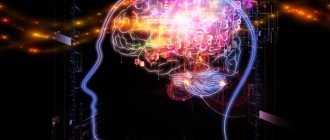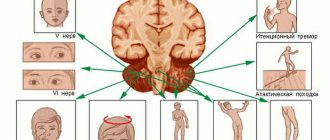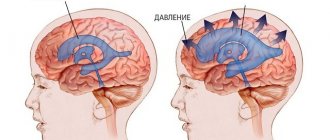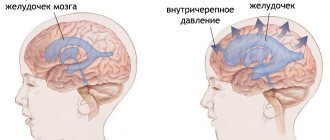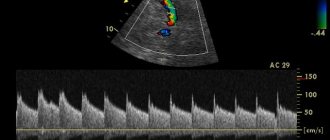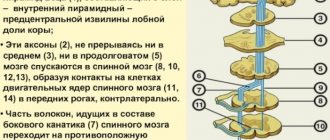Intellectual disabilities in children
Intelligence is a complex concept that includes the ability to accumulate experience and knowledge, the ability to apply them to solve problems, and adapt. The prerequisites for the development of intelligence are cognitive functions - attention, memory, spatial perception, thinking, as well as psychophysiological characteristics - performance, initiative, cognitive interest. Intellectual impairments are qualitative and quantitative deviations in the development of mental abilities. They can be a central symptom of the disease (oligophrenia, dementia, mental retardation) or one of the secondary ones (epilepsy, schizophrenia, endocrinopathies). There are no exact data on the prevalence of intellectual disabilities; they are reliably more often detected among the rural population, which is explained by simpler living conditions that require less effort to adapt.
Causes of intellectual disabilities in children
Intellectual disability develops as a result of the negative influence of endogenous and exogenous factors. The more intense and early the exposure, the more serious disorders are determined in the child. The following groups of reasons are distinguished:
- Genetic changes. Deviations in intellectual development are determined by chromosomal abnormalities - trisomy (Down syndrome), chromosome deletions, uniparental disomies; with dysfunctions of individual genes (autism, Rett syndrome).
- Perinatal damage to the central nervous system. Hypoxia caused by maternal diseases (cardiovascular, endocrine pathologies, kidney, liver diseases), incompatibility of the pregnant woman and the fetus according to the Rh factor, the ABO system, intrauterine infections, intoxication, radiation exposure, severe emotional stress during pregnancy, and prematurity have a negative impact.
- Natal damage to the central nervous system. Complicated childbirth, accompanied by asphyxia, blood loss, and fetal injuries, can lead to organic and functional brain disorders.
- Postnatal damage to the nervous system. Intellectual impairments of varying severity develop with neuroinfections (encephalitis, meningitis), epilepsy, severe endocrine, autoimmune diseases, intoxications, traumatic brain injuries, dystrophies, and after clinical death.
- Mental, neurological disorders. Intellectual disorders arise against the background of behavioral, emotional, volitional defects, and pathologies of the analytical systems.
- Social factors. Deviations of intellectual development are revealed in disharmonious family relationships, an asocial lifestyle of parents, pedagogical neglect of children, and long stays in hospitals.
Pathogenesis
The pathogenetic basis of intellectual disorders in children is encephalopathic and cerebrasthenic changes in the central nervous system, psychosocial conditions of development. Functional, organic abnormalities of brain function according to their etiology can be hypoxic, traumatic, toxic-metabolic, infectious. They are manifested by excitation or inhibition of central nervous system activity, symptoms of intracranial hypertension, convulsive syndrome, dysfunction of the brainstem, insufficiency of cortical-subcortical interactions, and local damage to certain areas of the cortex. The severity of an intellectual defect, its totality or partiality, and the possibility of compensation are determined by the psychological characteristics of the child and social conditions.
Classification
Intellectual disabilities in childhood are divided into quantitative and qualitative. The first group includes:
- Impaired mental function. Slow maturation of the morphofunctional systems of the brain occurs under the influence of unfavorable factors and is expressed by the immaturity of psychomotor and cognitive functions.
- Mental retardation. It is a mental retardation - a persistent congenital or early acquired impairment of intelligence. There are three degrees: mild (moronicity), moderate (imbecility), severe (idiocy).
- Dementia. Acquired persistent or progressive dementia, developing as a result of the loss of formed intellectual functions.
Qualitative intellectual impairments in children are caused by uneven development of mental, psychophysiological, emotional and volitional functions. We are talking about a disorder in cases where the uniqueness of the intellect prevents the child from adapting to the environment at the level of everyday self-care, social interactions, and mastering educational skills. Qualitative changes are found in schizophrenia, early childhood autism, diseases of the sensory organs, and speech pathologies.
Symptoms of intellectual disabilities in children
The clinical picture of intellectual impairment is varied. Symptoms should be considered in accordance with the classification: with quantitative changes, there is a decrease in learning ability, difficulties/impossibility of self-care, with qualitative changes, a decrease in intelligence is combined with mosaic, partial development of individual functions.
Impaired mental function. The level of intelligence is below average, reaching levels borderline with mental retardation. There are two variants of the clinical picture. If cognitive activity is impaired due to insufficient development of the emotional-volitional sphere, a lack of interest in cognitive activity comes to the fore: children are active, impulsive, and prefer simple games. They are not interested in creative and educational activities; they are difficult to organize and encourage reading and drawing. The second option is insufficient formation of the prerequisites for intelligence (memory, performance, attention). Children lack initiative, are not independent, are overly active or passive, get tired quickly, work at a slow pace (signs of cerebrovascular disease).
Moronism. It is characterized by the primitiveness of thinking, its attachment to specific, visual situations, insufficient differentiation of emotions, and weakness of volitional impulses. Patients later master self-care skills, are able to dress independently, and perform hygiene procedures. According to a special curriculum, they master writing, reading, and counting. Teenagers learn simple working professions.
Imbecility. Thinking is slow, stiff, experience is difficult to adopt. Intellectual-mnestic functions are reduced. Social interaction is limited and learning skills are impossible. Children are delayed in mastering self-care and simple homework.
Idiocy. Characterized by a lack of speech and the ability to establish productive contact with others (with the exception of single executions of simple commands). There are often concomitant neurological pathologies and diseases of internal organs. Mobility is limited and self-care is not available.
Damaged and deficient development. The unevenness of intellectual impairments is explained by the mosaic nature of the damage to the central nervous system: some functions are developed and continue to develop at a normal pace, others slow down (depending on the location of the damage - speech, spatial, auditory-verbal perception, memorization). Complex hierarchical connections fall apart, and intellectual retardation develops. Deficient development leads to intellectual impairment based on a primary defect - pathology of the analyzer (hearing, vision), motor system.
Distorted and disharmonious development. It is caused by an ongoing pathological process that disrupts the uniform development of functions. Children have well-developed verbal intellectual functions, but adaptation is complicated by the difficulty of assimilation and understanding of social rules. Or the child has unique mathematical abilities, but everyday skills are difficult.
Intellectual disorders in children
General information
Intellectual disability in children (mental retardation) is a persistent, irreversible impairment of cognitive activity caused by organic damage to the brain. It is these signs: persistence, irreversibility of the defect and its organic origin that should be primarily taken into account when diagnosing children. The pedagogical criterion for diagnosing children with mental retardation is their low learning ability. Children with intellectual disabilities need care from teachers and parents. The role of adults is to make a child’s life easier in the world, to adapt him to society.
You may be interested in: Violations of the volitional sphere Sleep disorders
Symptoms of intellectual disabilities
Symptoms of mental retardation include diffuse damage to the cerebral cortex, as well as local lesions that lead to disturbances in mental development. Local lesions cannot be excluded, which lead to a variety of disorders in the development of mental higher cognitive processes, namely:
- perception;
- memory;
- verbal-logical thinking;
- speech.
There may be disturbances in the emotional sphere (increased excitability or excessive inertia). With intellectual impairment in children, physical development may be impaired:
- Dysplasia;
- deformation of the shape of the skull;
- limb deformity;
- motor impairment;
- gigantism;
- dwarf stature.
Children with intellectual disabilities
A child with an intellectual disability may be passive in understanding the surrounding reality. According to the degree of mental retardation and the ability for long-term learning, experts distinguish deviations:
- Idiocy. Characterized by a deep degree of retardation and severe coordination disorders. It is difficult to develop self-service skills, and a full understanding of the world around us is inaccessible.
- Imbecility. Characterized by mild intellectual impairment compared to idiocy. Children with this developmental disorder have every chance of mastering speech and mastering some work skills.
- Moronism. The characteristics of children with intellectual disabilities of this form do not allow them to study in regular schools due to the reduced level of mental abilities and the specifics of the emotional-volitional sphere.
The difficulties of teaching and raising such children are associated with the underdevelopment of the analytical and synthetic functions of higher nervous activity. To this should be added rather poor health and somatic disorders. In the future, adults will have a limited range of professional and labor activities. In addition, there is a separate group of children with mental retardation.
A separate group of children includes students who have difficulty mastering the basic school curriculum. But such children cannot be classified as mentally retarded, since they demonstrate sufficient ability to communicate and a wide zone of proximal development. The causes of mental retardation can be different. There are mental and psychophysical infantilism , which is directly related to the harmful effects on the central nervous system during pregnancy.
Adaptation in society
Children with intellectual disabilities, in some cases, study in regular educational schools. But if the disorders are dominated by pronounced cerebrasthenic disorders, they need special educational institutions. In such schools there is a system of special treatment measures for such children and psychological and pedagogical correction. Doctors identify various deviations in the emotional-volitional sphere and cognitive activity of the child. The following factors are common to delayed child development:
- Emotions are immature;
- lack of intellectual skills;
- low performance;
- poor vocabulary;
- difficulties in verbal and logical operations;
- narrowed view of the world;
- inability to use the game for development;
- slow perception of events;
- low level of self-control.
Teaching children with intellectual disabilities
When teaching children with intellectual disabilities and for their socialization, oligophrenopedagogy methods are used. Children with idiocy are usually not subject to treatment and, with the consent of their parents, can live in special institutions where they are provided with proper care and medical assistance. After reaching adulthood, such children are transferred to orphanages, where they learn to write, read, and can work in special workshops. Difficulties in learning are associated with the fact that such children experience difficulties in understanding the connections between sounds and letters, sets and their numerical expressions, and the inability to establish and understand temporal, spatial and cause-and-effect relationships between objects and phenomena. Intellectual impairment in children in the form of developmental delay usually manifests itself in difficulties in the formation of basic mental operations - synthesis, analysis, comparison and generalization.
In general education schools, children with intellectual disabilities are often subject to ridicule from their peers, which negatively affects their psyche. Therefore, teachers and doctors are inclined to believe that it is more humane to educate such children in specialized institutions. With the right approach, it becomes possible to lay down the necessary knowledge and instill learning skills, which allows them to subsequently transfer them to a regular school.
Teaching children with intellectual disabilities requires an integrated approach , both from doctors and educational psychologists. It is necessary to use all possible resources so that a child with intellectual disabilities can develop his or her existing abilities to the maximum and adapt more easily to adult life.
Facebook Youtube Viber Telegram
Complications
In the absence of pedagogical, medical and psychological assistance, intellectual disabilities in children are complicated by social maladjustment and psychopathic disorders. Patients become unable to attend group classes: they show aggression, are impulsive, disinhibited or lack initiative, tired, apathetic. In severe forms of intellectual pathology, complete dependence on parents develops; patients constantly need outside help. Without medical supervision, the risk of development and progression of concomitant somatic, including neurological, diseases is higher.
Diagnostics
Intellectual disabilities in children are determined by a psychiatrist. Additionally, a clinical psychologist and neurologist are involved in the diagnostic process. The following methods are used during the examination:
- Clinical. During the conversation, the psychiatrist determines the symptoms of the disorder, possible causes, the level of maladjustment of the child, and the development of everyday skills. When talking with the patient, the specialist evaluates vocabulary, level of general awareness, ability to solve logical problems, and ability to abstract. At the same time, he observes emotional reactions, behavioral characteristics, and productivity of contact.
- Pathopsychological. The psychologist conducts a comprehensive examination, the central place of which is occupied by intelligence tests. The most common is the Wechsler technique, which consists of two parts - verbal and non-verbal. Each is represented by several subtests aimed at determining various components of intelligence (orientation in everyday and social situations, vocabulary, spatial and figurative thinking, etc.). Additionally, tests are performed for attention, mechanical and semantic memory, the formation of the analytical-synthetic, abstract-logical thinking function.
When making a diagnosis, the doctor takes into account the data of instrumental examinations of the brain (EEG, MRI, CT), the conclusions of specialized specialists (neurologist, endocrinologist, audiologist, ophthalmologist), and the characteristics of teachers. Intellectual impairment in children must be differentiated from normal development in specific conditions. Example: children of small peoples and other cultures are well adapted to their living conditions, are teachable, have a sufficient supply of knowledge, but find it difficult to solve the everyday problems of residents of large cities.
The level of intelligence began to fall because people do not need to survive
Researchers from Stanford University claim that humanity's intelligence is declining. According to them, the law of natural selection, discovered by Darwin, has ceased to work. Because now we no longer need to fight for survival.
We will order pizza at home, take frozen chicken wings out of the refrigerator, and if we suddenly sneeze, we will quickly get rid of the disease by swallowing an antibiotic.
Scientific and technological progress has saved us from running naked through the jungle chasing a mammoth. And our distant ancestors, in order to find food, a place to live, and even protect their simple household and family from enemy neighbors, had to use remarkable thinking abilities.
And these two processes - surviving and thinking - as it turned out, are tightly connected.
“The genes responsible for the development of intelligence began to develop at an incredible pace in our ancestors even before they began to settle throughout the Earth, emerging from Africa, the “cradle of humanity,” explains lead author of the study, Dr. Gerald Crabtree. “After all, they had very difficult conditions for survival. Therefore, gene mutations led to the peak development of thinking abilities.
And then, according to Crabtree, “with the development of agriculture and urbanization, life became much easier,” and human intellectual power began to decline. Humanity has become weaker in its resistance to mutations leading to intellectual disabilities. Therefore, compared with our distant ancestors, modern man has become considerably stupid.
“We reached the peak several thousand years ago and have been going downhill ever since,” Crabtree is convinced.
According to neuroscientists, from 2 to 5 thousand genes are used in the development of intelligence. It is also known that genes involved in brain function are extremely susceptible to mutation. The scientist calculated the frequency with which harmful mutations appear in the human genome. And it turned out that over the course of three thousand years and 120 generations, humanity suffered two or more mutations, which, alas, led to a deterioration in our intellectual abilities. Professor Crabtree called them “stupid mutations.”
“If we had a time machine, and we suddenly found ourselves in Athens in 1000 BC,” Crabtree fantasized, “then our interlocutors would appear to us smarter than our contemporaries.”
Within five years, Crabtree says, scientists will be investigating every one of the millions of gene mutations that could compromise our intellectual development. And then they will figure out how to correct these mutations. And maybe we'll get wiser again.
SKEPTIC'S COMMENT SKEPTIC'S COMMENT
Doctor of Psychological Sciences Georgy Kruglitsky: Doctor of Psychological Sciences Georgy Kruglitsky:
— The hypothesis lacks solid evidence. Firstly, it is impossible to assess the intelligence of our distant ancestors. Secondly, contrary to the claims of some researchers that stupid people give birth more, which means humanity will become dumber, the average IQ level has been growing in recent years.
In any case, such theories of the evolution of intelligence need radical rethinking. Moreover, recently most scientists have questioned the value of IQ tests. It turned out that those who cracked problems like nuts were considered dull in life. And vice versa: those who did not master even two tasks from popular tests showed miracles of intelligence in a variety of circumstances. In addition, IQ is easily influenced by, for example, education and culture. Surely, today even a Nobel Prize winner will miserably fail an intelligence test prepared for him by an 18th-century Indian from the Sioux tribe.
Recently, Nobel laureate, psychologist Daniel Kahneman from Princeton University (USA) made an amazing discovery. He found that when processing information, our brains have access to two different systems. IQ tests reveal only one side of the brain—the part involved in rational problem solving. But in everyday life, the brain works in a completely different direction - it is “turned on” to intuition. It was this powerful force that allowed people to survive and spread across the Earth. Today, our rational mind creates smart machines, looks at distant quasars and climbs inside a cell. But his intuition fails him, because all great scientific discoveries can lead to the death of humanity. Let's remember Hiroshima, Fukushima, Chernobyl. Now the threat of a third world war looms. Therefore, talking about the stupidity of people is unscientific. Rather, it is a matter of short-sightedness, which has become inherent in modern man, whose intuition has atrophied.
The inability to see a mistake and not make it, and also when solving a problem not to strive to know ourselves as best as possible - these are the roots of our stupidity. Therefore, even a high intellectual can be stupid. In general, stupidity is especially dangerous in people with high IQs, because they are often given great responsibility.
BY THE WAY
Only 20 percent of intelligence is passed on to us from our parents.
Researchers studied the DNA and IQ test results of tens of thousands of children Researchers studied the DNA and IQ test results of tens of thousands of children
Why is one smart and the other stupid? What does the development of intelligence depend on - on nature or nurture? Wanting to find answers to these questions, Australian scientists from the University of Queensland studied the genes and administered IQ tests to 18,000 people aged 6 to 18 years from four countries: Australia, the Netherlands, the UK and the USA.
And it turned out that only 20 percent of intelligence is passed on to a child. Only in rare cases do parents pass on up to 40 percent of their “brain” to their children. Until now, it was believed that at least 50 percent depends on nature. It turns out that if a child has not very smart ancestors, this does not mean that he will follow in their footsteps. Education and environment help develop IQ quite high.
For example, scientists have found out that orphanage children from families in which parents did not shine with their abilities, after their adoption into families where they were seriously involved in their education, even became child prodigies.
What do we know about geniuses? Read on the website.
Treatment of intellectual disabilities in children
Treatment of intellectual disabilities is aimed at eliminating reversible causes, providing support and symptomatic therapy for persistent congenital pathology. The following types of medical, psychological and pedagogical assistance are indicated:
- Drug treatment. Drugs are selected taking into account the etiology of intellectual impairment. For organic brain damage, cerebral circulation correctors, nootropics, and psychostimulants are prescribed; for diseases of the endocrine system - hormonal agents; for psychotic disorders - antipsychotics; for emotional and behavioral abnormalities - sedatives, tranquilizers.
- Psychocorrection. Classes are conducted by psychologists, oligophrenopedagogues, and defectologists. The goal is determined by the depth of the intellectual impairment and the child’s learning ability. Mild forms can be corrected by more careful elaboration of lagging functions. In case of persistent deviations or decreased learning ability, special programs are used aimed at developing practical, everyday skills that promote adaptation.
- Rehabilitation. With mild impairments, children are involved in educational, sports, and creative activities in schools and additional education institutions. Persistent deviations require referral to special schools. To prevent social and labor disadaptation, individual rehabilitation programs are being developed.
ACQUIRED DISORDERS (DEMENTIA)
Disorders of intellectual activity - changes in the process of rational cognition, inferences, judgments, critical abilities.
Dementia There is a distinction between so-called dementia (translated from Latin, this term dementia literally means “decreased intelligence”) - acquired dementia and oligophrenia - congenital dementia. Based on the characteristics of the clinical picture, the following types of dementia are distinguished.
Organic dementia is dementia caused by vascular diseases of the brain, syphilitic and senile psychoses, and brain injuries. Various dementias are described in more detail in the relevant sections of the book (see contents). Organic dementia is usually divided into two groups: total (diffuse, global) and partial (dysmnestic, partial, lacunar). According to the International Classification of Diseases, 10th revision, the following types of dementia are divided: dementia due to Alzheimer's disease; vascular dementia; dementia in Pick's disease, Huntington's disease, Parkinson's disease, AIDS; unspecified dementias. Total dementia is caused by a pronounced decrease in all intellectual functions and a lack of criticism of one’s condition. An example of this is the so-called senile dementia, as well as dementia with progressive paralysis (paralytic dementia). Partial (dysmnestic) dementia is manifested by severe memory impairment. Other intellectual functions are usually affected secondarily. These patients retain the ability to judge and have a critical attitude towards their condition. It is difficult for them to learn new things, but old knowledge, especially professional, well-established knowledge, can be retained for quite a long time. Due to their critical attitude towards themselves, such patients understand their situation, try to avoid conversation in which they could detect memory disorders, constantly use a notebook, and write in advance what they need to say or do. A typical picture of such partial dementia can be observed with cerebral atherosclerosis or syphilis of the brain. Among acquired dementia, schizophrenic and epileptic dementia are also distinguished.
Schizophrenic (apathetic, atactic) dementia is characterized by intellectual inactivity, lack of initiative, while at the same time, the ability to perform mental activity can be preserved for a long time. That is why the intelligence of such patients is compared to a cabinet full of books that no one uses, or to a musical instrument that is locked and never opened.
Epileptic dementia manifests itself not only in a significant decrease in memory, but also in a peculiar change in thinking, when a person begins to lose the ability to distinguish between the main and the secondary; everything seems important to him, all the little things seem significant. Thinking becomes viscous, unproductive, pathologically detailed, the patient cannot express his thoughts in any way (it is not for nothing that epileptic thinking is sometimes called labyrinthine). Also characteristic is a narrowing of the range of interests, focusing exclusively on one’s condition (concentric dementia).
Article “Children with intellectual disabilities”
"Children with intellectual disabilities"
Characteristics of preschool children with mental retardation.
Physical condition of this category of children (diagnosis: oligophrenia to the degree of debility):
In many children, the development of upright standing is delayed (until the end of the 2nd year of life), that is, they begin to hold their head up, sit, stand, and walk later than ordinary children. Later, after three years, children experience poor health, general weakness, fatigue, exhaustion, and nervousness.
Organic disorders affect the formation and development of individual systems and internal organs of children. Many of them lag behind the age norm in weight and height. More often than in ordinary children, postural disorders, spinal curvatures, and deformities of the chest and limbs occur.
In general, children do not experience significant motor impairment. However, salivation (salivation) and a nasal tone of speech are observed. The specific state of speech and non-speech articulatory motor skills, as well as difficulties in performing tasks in visual and everyday activities, poor coordination of movements indicate the presence of motor disorders. Sometimes there are deviations in the state of the respiratory system: increased breathing, uneven rhythm. In many children, the oral (oral) type of breathing dominates, which contributes to the development of upper respiratory tract pathology.
The cardiovascular system may be characterized by uneven heart rate, excessive instability, hyper- and hypotension. As a rule, such children complain of headaches, general weakness, drowsiness, and hyperfatigue. In addition, disturbances in the functioning of the visual, auditory, and tactile analyzers of an unexpressed nature may accompany the main defect.
Thus, the uniqueness of the physical development of children with mental retardation is expressed in the characteristics of their functional systems and organs, which is a consequence of the manifestation of organic damage to the central and peripheral parts of the cerebral cortex.
Characteristics of the psychoemotional and sociocultural status of mentally retarded children of preschool age:
Almost all children with mental retardation experience an absence or a significant decrease, compared to ordinary children, of interest in the environment, a general pathological inertia, which does not exclude loudness, irritability, and disinhibition.
At an early age, a child is not interested in toys hanging above the bed or in the hands of an adult. Later - toys of other children, role-playing games with them.
The prerequisites for speech development are formed late (by the age of 4); objective perception, objective actions, communication with adults and, in particular, pre-verbal means of communication. Such reflex processes as babbling and humming, which normally appear in the first months of life, may be absent in the ontogenesis of an oligophrenic child.
The child has a low level of interest in the environment and insufficient development of the perception process, which predetermines the impossibility of his independent orientation in the conditions of the task, the need for a detailed explanation of it, and makes it difficult to change one type of activity to another. In addition, the connection between action and word is broken.
Actions are not sufficiently conscious; the experience of action is not recorded in words and is not generalized. The connection between the main components of cognition - action, word and image - is not perfect. The turning point in the development of a mentally retarded child is the fifth year of life.
The child begins to show interest in toys, and, consequently, receives the simplest ideas about their properties, characteristics, relationships, and is able to make choices according to the model. For the vast majority of children, by the end of preschool age the objective-practical (visual-effective) type of thinking remains dominant.
Play activity is characterized by elementary manipulations with toys before the age of five; after the age of five, procedural actions appear. The game exhibits stereotyping, formality of actions, there is no plan or plot elements. Children do not use substitute objects, and aggressive tendencies may appear. These children have no productive activity (constructive skills, drawing) outside of a specially organized psychological and pedagogical process.
Self-service skills are formed only towards the end of the preschool period, and there may be cases when children still do not understand the sequence and logic of the actions included in the skill.
Approximately 60% of children have specific speech disorders such as alalia (from Greek - absence of speech) - this is a systemic underdevelopment of speech, in which the phonetic-phonemic and lexico-grammatical aspects and dysarthria (from Greek - articulation disorder) suffer - this is a violation of the pronunciation aspect of speech caused by an organic insufficiency of innervation of the muscles of the speech apparatus (porridge in the mouth).
In general, most preschoolers with intellectual disabilities master basic speech only by the age of 4-5 years. Sound pronunciation is impaired. Phrasal speech is replete with phonetic and grammatical distortions. The semantic side of speech is underdeveloped. Echolalic speech may often be observed. The regulatory and, most importantly, communicative functions of speech develop only within the framework of a specially organized educational process.
A speech defect negatively affects the entire development of the child, making it difficult for children to communicate with each other and with adults, as well as prepare for learning to read and write. The imperfection of the communicative speech function is not compensated for in preschoolers with impaired intelligence, as is the case in children, for example, with hearing impairment, by other means of communication, in particular facial and gestural. This determines the presence of cases of rejection of such children in groups of ordinary peers.
The correction work system includes:
Formation of cooperation between a child and an adult and the formation of ways to assimilate sociocultural experience;
Physical education and development of mentally retarded children;
Formation of mental processes (mental education);
Formation of play activity of children with mental retardation;
Labor education and training of mentally retarded children;
Moral education of children with mental retardation;
Musical education and development of children's rhythmic abilities;
Non-traditional practices for the rehabilitation of children with disabilities.
If the developmental disorder is severe, or if the child is unable to work in a group, individual correctional classes are conducted. Such classes are conducted by a speech pathologist teacher with each child 3 times a week. Particular attention is paid to the development of understanding of addressed speech, activation of one’s own coherent speech, development of the articulatory apparatus, formation of grammatical structure, and correction of pronunciation. For example, for disinhibited children with severe behavioral disorders, classes are needed that educate and train voluntary attention, the ability to distribute attention, concentrate it, and perform several actions simultaneously (for example, listen to the teacher and classify object pictures). Such classes are conducted with the obligatory inclusion of game material and manual subject-practical activities.
Characteristics of children with intellectual disabilities
One of the main characteristics of children with intellectual disabilities is a persistently pronounced decrease in activities aimed at understanding the world. Based on the degree of mental retardation and learning ability, doctors divide such deviations into:
- Idiocy, which is the deepest degree of mental retardation and is characterized by severe impairments in coordination of movements, motor skills and spatial orientation, which in some cases forces them to a recumbent lifestyle. With such intellectual impairment, it is very difficult for children to develop even basic hygienic self-care skills. It is practically impossible for them to comprehend the world around them, and speech either does not develop at all or is developed to a limited extent;
- Imbecility, which is characterized as a milder intellectual disability in children compared to idiocy. Such children have a higher chance of mastering speech and mastering simple work skills;
- Debility, which is considered the mildest course of the disease. The characteristics of children with intellectual disabilities of this form do not allow them to study in regular schools due to the reduced level of mental abilities and the specifics of the emotional-volitional sphere. Difficulties in training and education are associated with the underdevelopment of the analytical and synthetic functions of higher nervous activity. Poor health, somatic disorders and features of the incentive system significantly limit the range of their future professional and labor activities.
What reduces our intelligence? Or the reasons why we grow dumber
Smoking causes chronic bronchitis and atherosclerosis.
This habit also
provokes lung cancer and coronary heart disease. But it turns out that the list of consequences of cigarette addiction is not limited to this. As Scottish scientists found:
Smoking negatively affects the brain and reduces intellectual abilities.
To come to this conclusion,
Researchers from the University of Aberdeen examined 465 volunteers aged 64 years. Half of them were heavy smokers. First, they were given a battery of psychological tests to assess IQ and memory. The scientists then compared them with the archived results of a similar test conducted more than half a century ago, when the participants were 11 years old.
As it turned out,
smokers “lag behind” their non-smoking peers on all types of tests. Their ability to think logically, as well as their ability to memorize and reproduce information, has significantly decreased. Even when scientists excluded the influence of various “third” factors (social status, level of education, nature of work, alcohol consumption, etc.), although the difference decreased, it still remained large.
Researchers don't yet know
what smoking does to the brain.
But there is a version that nicotine and cigarette tars make nerve cells hypersensitive to the action of free radicals - toxic compounds formed during redox processes. In addition, the resins themselves increase the content of free radicals in the body, which also increases the risk of damage to brain cells. Source
Passive smoking reduces memory and weakens the nerves and impairs the functioning of the nervous system as a whole.
Even
You yourself have never touched a cigarette, but are forced to stay in a smoky room for a long time, there is a high risk that your memory will fail long before old age.
Experts say so
British Northumbria University Tom Heffernan and Terence O'Neill. They conducted a study of the cognitive (that is, those responsible for communication and assimilation of information) abilities of three groups of people. In one group there were heavy smokers, in another - those who were forced to inhale other people's tobacco smoke for a long time in the office or at home, and in the third - lucky ones who managed to avoid any contact with nicotine.
All three groups
The subjects were tested on chronological and event memory. That is, people were given to quickly memorize some texts, poems, and were shown pictures that had to be memorized in chronological order. At the end of the experiment, it became clear that passive smokers forgot almost 20% more compared to non-smokers, and active smokers retained information a third worse, says Addiction magazine.
The authors of the work are sure
that passive smoking not only has a bad effect on the bronchi and lungs, but also on the daily functions of our brain.
And they add that it can negatively affect not only memory, but also mental health. So, those who do not smoke, but have a high level of cotinine in their blood, a by-product of the breakdown of nicotine, have an increased risk of neuroses and a lower threshold for resistance to stress. Source
Israeli Study: Smoking Reduces IQ
As Israeli scientists have established,
Smoking not only increases the risk of respiratory and cardiovascular diseases, but also directly affects the mental abilities of a person addicted to tobacco. Heavy smokers have a sharp decline in IQ.
Medical center specialists
Sheba in Tel Aviv recruited twenty thousand male volunteers between the ages of 18 and 21 for the study. A thorough examination revealed that young men who smoke a pack of cigarettes a day before have a lower IQ than non-smokers. Moreover, the more cigarettes a young man needs per day, the weaker his mental abilities are.
For those who did not produce
and did not inhale tobacco smoke, the average IQ was 101 points.
For the average smoker, it decreased to 94, and for those who smoked more than one pack of cigarettes per day, it did not exceed 90. This was convincingly demonstrated by the results of IQ tests of twins, whose mental abilities are initially the same. Source
The importance of intelligence and the problem of its disorder
Intelligence is the mental quality of a person, which is expressed in the ability to perceive, comprehend and solve assigned problems. Since this concept implies the constant acquisition of new knowledge and skills, it is believed that developing a level of intelligence is quite possible. The important qualities of this category, which each person possesses, are curiosity, flexibility of mind, and breadth of thinking.
If the level of development of intellectual abilities at a certain age is insufficient, then we are talking about a violation. In such cases they speak of congenital or acquired dementia. The first disorder is called oligophrenia, the second – dementia.
The so-called “atrophy of the mind” is a psychiatric syndrome in which an individual loses the ability to understand the cause-and-effect relationships of what is happening to him and around him, to draw conclusions, to form judgments about events and exciting incidents, feelings, sensations.
Do we get stupid as we age?
Author Yana Filimonova
Updated: 10/23/2019 14:03 Published: 02/06/2018 19:00
Science » Ecology » Man
A common belief is that a person's intellectual abilities inevitably decline with age. It is believed that, having finished school and graduated from college, we acquire the bulk of knowledge, acquire the main working skills until the age of 30-35, and then a decline necessarily begins. We believe it and... we are afraid. But do people really get dumber with age?
66 shared
The first thing I would like to note is that the feeling that you have become stupid is irrational, like any feeling. Some real facts may serve as an impetus for it, but it would be hasty to draw conclusions based on it. Therefore, let's look at the scientific arguments.
What happens to the brain as a person grows up? Infants and young children develop their brains most rapidly. For the first time, neural connections are established, which will subsequently become the basis for the skills familiar to an adult - walking, speaking, reading and writing. But can we say that the average baby is smarter than a student?
Here, by the way, is the first fact: the high intensity of processes in the brain does not yet mean the highest intellectual abilities. The baby develops so actively because he needs time to lay the “base” for his future life. The same can be said about schoolchildren and even students.
The last grades of school and during college (that is, between the ages of approximately 15 and 25 years) really mark the peak of the ability to remember new information and master unfamiliar subject areas. This is partly due to biochemical processes in the brain: nerve cells begin to gradually die after 20 years.
Although, as studies have shown, the volume of dead cells is insignificant and actually has virtually no effect on a person’s thinking abilities, especially considering that the number of neurons themselves is only 10 percent of the total volume of the brain. But there are other reasons: the less knowledge we have, the easier our brain absorbs it, like a sponge.
Causes of pathological processes
As mentioned above, there are congenital and acquired intellectual disabilities. Each type of pathology has prerequisites for its development.
Oligophrenia or congenital dementia is a state of mental underdevelopment. The reasons for its development are factors influencing the process of maturation of the child’s brain. These include the following pathologies:
- viral encephalitis;
- degenerative pathologies of the brain;
- chronic hydrocephalus;
Microcephalus - dysfunction of the endocrine system;
- vitamin B12 deficiency;
- microcephaly;
- congenital infections (herpes);
- negative effects on the fetus during the period of intrauterine development of certain factors (taking certain medications, alcohol abuse, the presence of diabetes mellitus in the mother, radioactive and x-ray radiation);
- prolonged fetal hypoxia;
- brain damage caused during childbirth.
Dementia (dementia acquired in adulthood) is a decrease in a person’s cognitive activity and loss of knowledge and skills acquired earlier. The provoking factors in this case are:
- high blood cholesterol levels;
- severe autoimmune diseases;
- complications of kidney and liver diseases;
- alcoholism;
- vascular disorders of the brain;
- traumatic brain injuries;
- chronic metabolic disorders;
- deviations in the functioning of the endocrine system;
- infectious diseases (chronic meningitis, viral encephalitis);
- severe intoxication of the body (in particular, heavy metal poisoning).
Intellectual development disorders in children are possible due to the following factors:
- gene and chromosomal abnormalities (Down syndrome, Rett syndrome, Alfie syndrome);
- premature birth;
- birth head injury;
- incompatibility of the child and mother according to the Rh factor;
- bacterial and viral brain lesions in early childhood;
- encephalitis;
- meningitis.
Mental retardation
This is a non-progressive decline in intelligence caused by congenital pathology or developmental disorders in early childhood and manifested in at least two areas of adaptive behavior. In total, 10 such areas are identified: communication, self-care, everyday skills, social activity, leisure, taking care of one’s health and safety, independent behavior, academic performance, behavior in a team, and work activity. Thus, assessment of intelligence is possible only in the context of a person’s behavior in a familiar circle, at home, in a team. Mental retardation can be mild, moderate or severe.
1. With mild mental retardation, the ability to learn is preserved. Approximately 75% of all mentally retarded persons fall into this category. Their development usually does not exceed the level of the third or fourth grade of school, however, in adulthood, with certain care, they are capable of independent life.
2. For moderate mental retardation, some skill training is possible. Most people in this category are able to acquire self-care skills, but they never achieve any significant educational success. They can live with a family and work in special workshops. Singles require constant care in a boarding school. This group includes approximately 20% of all mentally retarded individuals.
3. With severe (IQ - 25-45) and extremely severe (profound) (IQ below 25) mental retardation, patients are completely dependent on others. Some of them are bedridden, and all attempts to socialize them remain unsuccessful. This group includes no more than 5% of all mentally retarded persons.
Clinical picture
All intellectual disabilities are characterized by a general clinical picture and symptoms:
- deterioration of memory, perception, attention, thinking, speech;
- weakness of judgment;
- inability to generalize;
- lack of initiative;
- intellectual inactivity;
- passivity;
- low self-esteem;
- aggressiveness;
- limited vocabulary;
- weakness of cognitive interests;
- lack of habit of self-control;
- problems with logical thinking;
- narrow-mindedness;
- primitiveness of interests;
- difficulties in the process of acquiring new knowledge and perceiving information;
- inability to analyze materials and the current situation;
- difficulty switching attention from one subject to another;
- character traits such as vindictiveness, pickiness, pedantry;
- emotional impoverishment to the point of stupidity;
- reducing the volume of response, which is reduced to physiological needs;
- autism;
- lack and misunderstanding of speech;
- inactivity and unproductivity.
Autistic child
Depending on the type of intellectual atrophy, certain symptoms predominate, while others are not observed at all or are less pronounced.
In particular, autistic children are characterized by bradyphrenia with a predominance of depressive symptoms and intellectual impairment to varying degrees.
